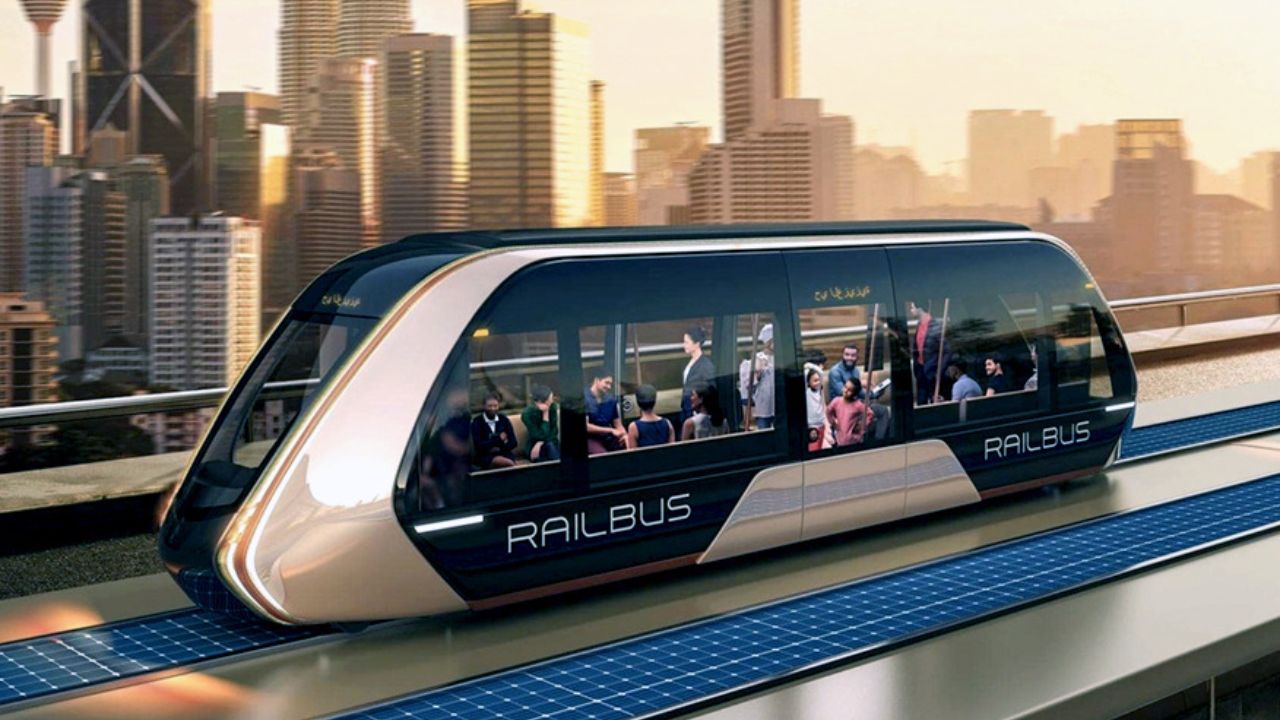
Dubai relies on the Rail Bus as part of its ambitious commitment to sustainable, high-tech urban development. The emirate continues to embrace innovations that enhance mobility, reduce carbon emissions, and promote smart infrastructure essential goals under the Dubai 2040 Urban Master Plan.
The Rail Bus concept, recently adopted by Dubai’s Roads and Transport Authority (RTA), is designed to integrate the flexibility of a bus with the capacity and efficiency of a tram or metro. As part of the UAE’s smart mobility initiative, the project is a bold shift away from fossil-fueled congestion to electric, AI-managed, and automated public transport.
What is the Rail Bus?
The Concept and Technology Behind It
The Rail Bus, also known as the Autonomous Rail Rapid Transit (ART) system, is a hybrid solution between traditional rail and rubber-tire bus systems. It follows a virtual track using LIDAR and sensor technology, without the need for metal tracks.
Key features:
- Operates on rubber tires guided by sensors
- Zero-emission electric motors
- Capacity for 200–300 passengers per unit
- Can extend or shorten based on demand
- Operates autonomously with AI traffic management
The system is designed for maximum flexibility and cost-efficiency, ideal for fast-growing urban centers like Dubai.
Why Dubai Relies on the Rail Bus
Environmental Benefits and Sustainability Goals
Dubai relies on the Rail Bus to reduce emissions and contribute to the UAE Net Zero 2050 strategy. As a fully electric transport solution, it emits zero CO2 and can operate entirely on clean solar energy supplied through Dubai’s DEWA grid.
- Expected to cut down emissions by 70% in targeted zones
- Reduces noise pollution by 60% compared to diesel buses
- Supports Dubai’s Green Mobility Strategy 2030
Sustainability is not just an environmental concern in Dubai—it is an economic driver, making eco-friendly transit a pillar of infrastructure investments.
Integration with Dubai’s Transit Network
Smart Connections and AI Integration
The Rail Bus will be integrated into Dubai’s existing public transport grid:
- Connects to Dubai Metro, Dubai Tram, and marine transport stations
- Operates on dedicated corridors and mixed-traffic lanes
- AI-powered scheduling and passenger load balancing
Dubai’s RTA plans to initially roll out Rail Buses in high-demand districts like Downtown Dubai, Business Bay, and Dubai Silicon Oasis before expanding to residential areas.
Impact on Real Estate and Urban Planning
Enhancing Property Value and Investor Confidence
Dubai relies on the Rail Bus not only to move people efficiently but also to drive urban regeneration. Transport infrastructure is a major value-add for real estate, and the areas connected by Rail Bus corridors are expected to experience:
- 12–18% increase in property value
- Surge in mixed-use developments and commercial leasing
- Greater demand for smart residential units
Communities such as Al Furjan, Jumeirah Village Circle (JVC), and Dubai South are already seeing renewed interest from investors.
At Valorisimo, we identify early-stage opportunities in transit-oriented developments (TODs), making the Rail Bus a key part of our market analysis.
Economic and Technological Synergies
Made for the Future, Built by the Best
Dubai’s Rail Bus project is in partnership with global mobility leaders including CRRC (China Railway Rolling Stock Corporation) and Siemens. The city is also investing in:
- AI control centers for real-time traffic coordination
- Smart ticketing systems integrated with Nol cards and facial recognition
- Predictive maintenance tools using IoT
This not only enhances the reliability of the system but also positions Dubai as a testbed for scalable smart mobility technologies globally.
Public Response and Timeline
Pilot Projects and Future Rollout
The first pilot Rail Bus is expected to start operation by late 2025. Initial public trials will include routes between Downtown and City Walk, with free ridership during the testing phase to encourage public adoption.
Feedback from commuters, real-time performance data, and environmental impact reports will shape future scaling to other districts.
Dubai relies on the Rail Bus as a symbol of how modern cities can blend sustainability, technology, and accessibility in one seamless mobility solution. It reflects the emirate’s long-term vision of becoming a smart, sustainable, and inclusive urban hub.
